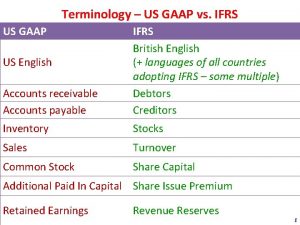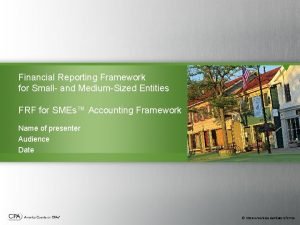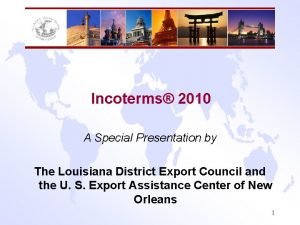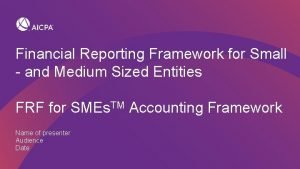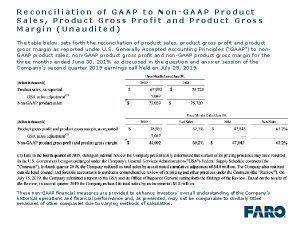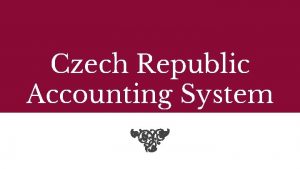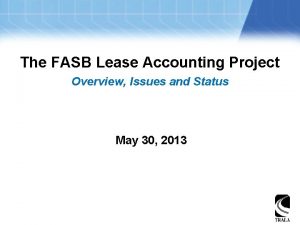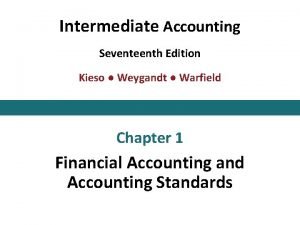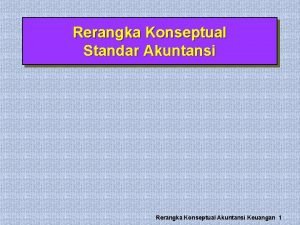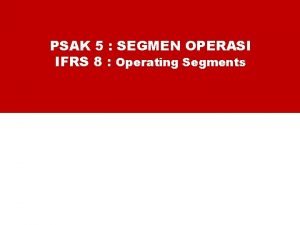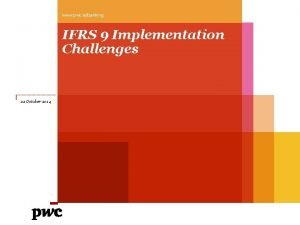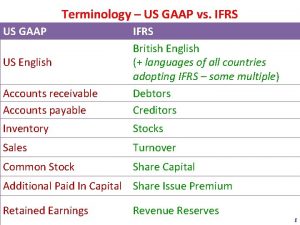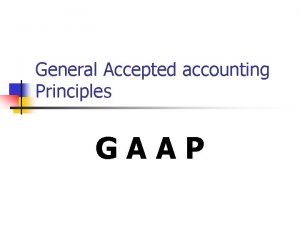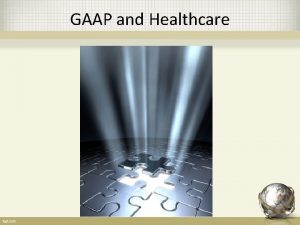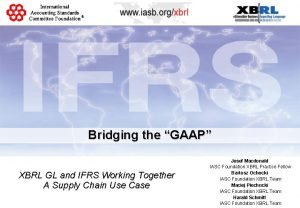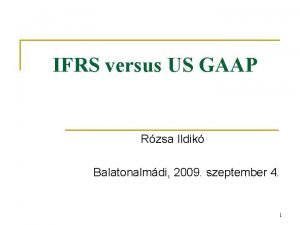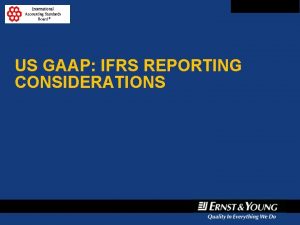Terminology US GAAP vs IFRS US GAAP Accounts



















- Slides: 19

Terminology – US GAAP vs. IFRS US GAAP Accounts receivable Accounts payable IFRS British English (+ languages of all countries adopting IFRS – some multiple) Debtors Creditors Inventory Stocks Sales Turnover Common Stock Share Capital US English Additional Paid In Capital Share Issue Premium Retained Earnings Revenue Reserves 1

Major Differences – US GAAP vs. IFRS US GAAP IFRS – SMEs ≈ 250 (+ ≈ 500 education materials) Pages ≈ 20, 000 ± ≈ 2, 500 Sections Numerous * Rules-based Approach – bright lines % of *Revenue Completiom – Constr. or Completed Contract Principlesbased 35 Principles-based % of C ompletiom Completiom 2

Major Differences – US GAAP vs. IFRS Balance sheet US GAAP IFRS Assets in reverse liquidity order A=L+E A–L=E Income Bad debts = statement expense Notes Bad debt = revenue offset Not referenced Referenced on on statements statement IFRS – SMEs Same as IFRS 3

Major Differences – US GAAP vs. IFRS US GAAP Currency IFRS – SMEs Need not be enterprise Primary currency Same as IFRS primary currency No revaluation *PP&E IFRS Capitalize construction period interest May revalue to FV at “highest and best use” Can revalue up or down Up creates “revaluation equity” Same as IFRS May expense construction period interest 4

Major Differences – US GAAP vs. IFRS More-likely -than-not (>50%) – midpoint of high/low One or two statement approach First Time IFRS – SMEs More-likelythan-not (>50%) – midpoint of high/low One or two statement approach First Time Extraordinary items None Cash overdrafts – offset other cash Allowed *Contingency recognition Comprehensive income *IFRS #1 US GAAP FAS 5 (> 95±%), except under FAS 141 R & FIN 48, if > 50% probable use weighted average One or two statement approach N/A Not allowed 5

Major Differences – US GAAP vs. IFRS US GAAP IFRS – SMEs Minimal Many specialized Industry focus special industries industry focus *Separate GAAP for nonprofits Yes Nonpublic Limited company focus Interim financials Special rules, interims often regular dates No No No This is SME’s Special rules, interims not regular dates Not addressed 6

Major Differences – US GAAP vs. IFRS US GAAP Not required, except SEC public co. requirements IFRS – SMEs 2 years Yes No VIESs, SPEs or equivalent VIEs – FIN 46 R, etc. SPEs Uncertainty in Income Taxes – FIN 48 Yes Limited No Revenue recognition (excludes ASU 2014 -09) Much detail Limited (>15 industries) detail Comparative Statements Fair Value – FAS 157 & 159 or equivalent 7

Major Differences – US GAAP vs. IFRS US GAAP Derivates – netting FV for derivative and related right to reclaim Not Permitted collateral with same counterparty under master agreement IFRS – SMEs Not permitted addressed Consolidation basis Power (management) Governance (ownership) Borrowing costs Capitalize and amortize Capitalize and Expense amortize 8

Major Differences – US GAAP vs. IFRS US GAAP IFRS – SMEs Operating leases Allowed (excludes new Std) Allowed Lease Very rules-based capitalization – only PP&E (excludes new Std) Principlesbased – all leases Principlesbased –all leases Deferred taxes Much, GAAP vs. US tax code Some, IFRS vs. Some, IFRS local tax vs. local tax *Deferred tax classification Current or noncurrent Noncurrent DTA – show VA Yes, gross to net No, net only (valuation allowance) 9

Major Differences – US GAAP vs. IFRS US GAAP *Inventory – LIFO Allowed IFRS – SMEs Not allowed Inventory Valuation Lower of cost or NRV Inventory – writeup previous writedown? No Yes PP&E – use FV? No Optional – must continue once adopted *PP&E – component depreciation Allowed – Required limited circumstances Yes Required 10

Major Differences – US GAAP vs. IFRS US GAAP Reimbursement Record if rights probable IFRS – SMEs Record if virtually certain LT debt Current, if meet Noncurrent refinanced after certain tests end of period Not addressed Loan covenant subsequently cured Status at period end Not addressed Capitalize and Borrowing costs amortize Capitalize and amortize Expense *Stock option vesting Front-end loaded Not addressed Status at financial stmt. issue date Straight line 11

Major Differences – US GAAP vs. IFRS US GAAP IFRS – SMEs Business combos *Capitalize R&D only No–R, No–D No–R, Yes–D – not limited to combos Expense all Impairments Not reversible Reversible, except GW Impairment Testing – general Two-step test – different for GW vs. others One step test, same for all Impairment Testing – Goodwill May waive two step test based on qualitative evaluation One step test, same for all GW carrying amount Not amortized Amortize up to 10 years 12

Major Differences – US GAAP vs. IFRS US GAAP IFRS – SMEs Financial instruments Levels 1, 2, 3 MV if known and reliable – if not, amortized cost Equity = residual interest Multiple Only most classes may residual class = be equity Only most residual class = equity More detailed + Related party Limited Compensation of disclosures key personnel Accd. liability Limited Breakdown by Prepayments disclosures category Receivables Breakdown by category 13

US GAAP Changes to Conform with IFRS « Revenue recognition – ASU 2014 -09 conforms US GAAP and IFRS with minor differences (adoption dates, interim disclosures) « FASB Simplification Initiative – decisions at 5/28/14 board meeting (guidance to be issued) ª Inventory measurement – at lower of cost or NRV ·Eliminates NRV + normal profit as “ceiling” ·No change in disclosures ·Adopt prospectively ª Extraordinary items eliminated ·Prospective adoption without prior restatement 14

Where Do We Go From Here? « Certain issues must be resolved for US to adopt IFRS ª US fully embrace principles-based approach ª Require comparative statements in US ª US greater use of FV and “more-likely-than-not” criteria (vs. FAS 5) ª Conformity in deferred taxes ª Conformity in impairment determination (one step test? ) ª Recovery of prior impairment writeoffs ª Elimination of LIFO (next slide) ª SEC (publicly entities) and FASB (all entities) agree to adopt IFRS 15

SEC Staff Position Re: Adopting IFRS ISSUED BY SEC STAFF IN 2012 – NON-BINDING COMMENTS « Inconsistent worldwide IFRS application ª Lack of IFRS enforcement in certain jurisdictions ª Some jurisdictions modify IFRS to suit regulatory needs « Higher than anticipated expenses ª Conversion to IFRS ª Reworking documents, contracts, regulations, etc. « Reduced US support for conversion to IFRS « Lack of timeliness by IFRS Interpretations Committee on addressing pressing needs « Difficulty in understanding and incorporating intricacies and regulatory policies of multiple jurisdictions « Lack of industry guidance in IFRS vs. US GAAP « Lack of funding or governing mandate of IFRS Foundation « Lack of progress on joint projects 16

Where Do We Go From Here? – LIFO « Many GAAP people feel LIFO theoretically untenable « Transitional issues for both tax and GAAP ª Eliminate LIFO reserve – FIFO, average cost, direct writeoff to income or retained earnings, etc. ? ª Grandfather existing inventories or companies? ª Taxes – defer or eliminate accumulated taxes, pay immediately, or create transitional treatment (e. g. , phase-out)? 17

Conforming US GAAP and IFRS « Still limited differences in disclosures, deposit liability measurement, investment companies, treatment of nonpublic entities, referencing, style, and spelling « Move to IFRS ª Public entities & Nonpublic entities – no immediate plans to adopt IFRS ª In period of adoption (if), disclose change if any in valuation technique and related inputs from application of amendments ª Quantify total effect of change, if practicable 18

Discussion Points 1. What impact, if any, will conversion to IFRS have on you and your organization? 2. Do you feel US adoption of IFRS will improve financial reporting? 19
 Accounts receivable ifrs vs gaap
Accounts receivable ifrs vs gaap Aquis entertainment share price
Aquis entertainment share price Ifrs vs gaap
Ifrs vs gaap Incoterms and revenue recognition us gaap
Incoterms and revenue recognition us gaap Gaap income statement
Gaap income statement Frf for smes vs gaap
Frf for smes vs gaap Stat to gaap reconciliation
Stat to gaap reconciliation Intermediate accounting chapter 2
Intermediate accounting chapter 2 Czech gaap
Czech gaap Dr gaap
Dr gaap Fas 13 straight line rent
Fas 13 straight line rent Intangible inputs
Intangible inputs What are accounting assumptions
What are accounting assumptions Generally accepted accounting principles adalah
Generally accepted accounting principles adalah Intermediate accounting
Intermediate accounting Kerangka konseptual ifrs
Kerangka konseptual ifrs Constraint in accounting
Constraint in accounting Psak 5 segmen operasi
Psak 5 segmen operasi Ifrs 9 implementation challenges
Ifrs 9 implementation challenges Aaoifi vs ifrs
Aaoifi vs ifrs
